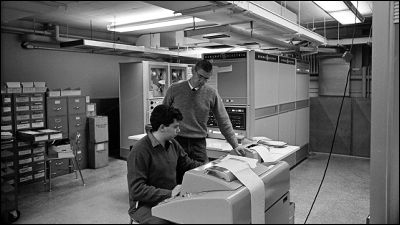What does a computer need to explode human creativity?

Computer technology, including AI have evolved significantly in recent decades, sometimes 'highly developed AI is a threat' both
Computers and Creativity
https://www.mollymielke.com/cc
Common computers in the early 1950s began as pure logic machines running on paper and punched cards. Computers that operate on basic mathematical operations were revolutionary at the time and are the basis of today's computers.
Then, in the latter half of the 1980s, a new system 'spreadsheet software' that replaced punch cards appeared. With the advent of spreadsheet software, you will be able to use calculations in new ways. And around this time, creations using computer applications appeared. For example, the earliest digital art, 'Ocilon 40,' is a long-exposure photograph of the waveform displayed using an oscilloscope that captures electrical vibrations and displays them on a screen.

In 1984, the graphic software 'SuperPaint' appeared and began to play an active role as a pioneer of creative tools. In this way, 'creative tools that nurture human creative thinking' such as text editors, spreadsheet software, and CAD software have been created one after another.
Milky believes that many creative tools were

by
Inspired by Mr. Engelbart, Mr. Ivan Sutherland developed a program ' Sketch Pad ' that pioneered GUI. In addition , JCR Rickrider and Alan Kay are inventing new inventions that expand the possibilities of computers. While such creative tools have raised expectations for human computers, they also have some problems.
One of the problems is that the technology industry's resources are focused on developing digital products that focus on artificial intelligence rather than creative tools. Large companies are investing in AI, but this business-driven technology development cannot invest in human creativity. AI itself is not creative in nature, it's just a realizer of human ideas. Milki points out that in order to increase human creativity, it is necessary to remove AI from computers and aim to build software that allows computers to expand human creativity.
In addition, the development community is focusing on interoperability to share and build functions with a large number of people, rather than standardizing the functions of creative tools and aiming for innovation in a small community. The rise of open source software development communities such as GitHub is helping to improve innovation between individuals. However, the risks of these interoperable development methods are 'delaying improvement,' 'adopting inconsistent features in open standards,' and 'reducing innovation through competition between healthy companies.' Mr. Milki also points out that there is.

On the other hand, standardization of creative tools is also thought to lead to the creation of a better environment for human creativity. In order for Engelbart's statement that 'computers have the power to change and expand human thinking' become a reality, software must adapt to each user's thinking process, Milky said. Says. Adapting creative tools to the user's thinking process is the first step in increasing human creativity on a computer, because flexible and scalable software creates a user's attachment to the software. Milky points out that it also has a business advantage.
Creative tools, unlike engineering tools, require you to compose content from scratch each time you create something. Creative tools provide some pre-defined text, symbols, and other options that users can use to get creative. In order for these options to be efficient for users, they should remove complexity from the user interface design stage and make them simple and easy for everyone to use, Milky said. .. On the other hand, there is an opinion that 'minimized options hinder the creativity that comes from combining options', but Mr. Milky said, 'By simplifying the experience of using the tool, creative tools have been used so far. It will be easy to use even for people who have never used. '
Since its inception, computers have been a stubborn tool that humans have to deal with. However, the emerging interoperable, formable, community-driven digital creative tools have immeasurable potential to make computers co-creators of human creativity, and to a large number of users. Milky concludes that it is spreading innovation.

Related Posts:
in Posted by log1p_kr







